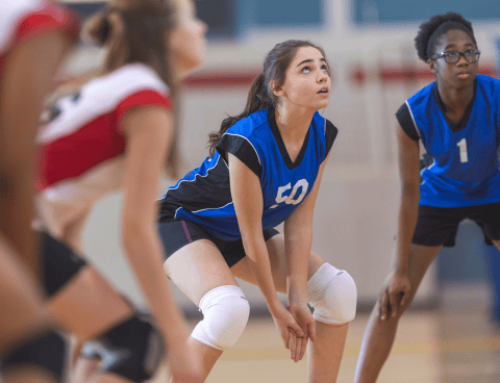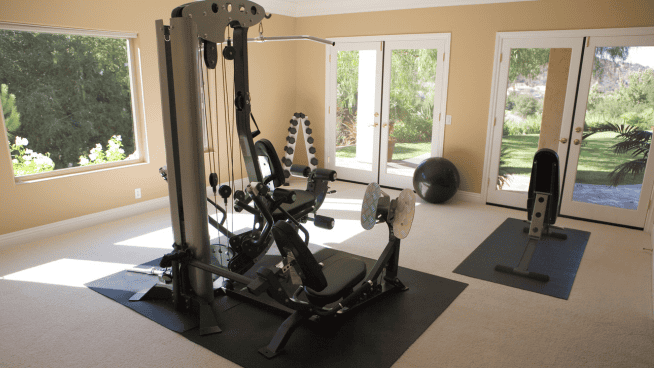How Volleyball Players Should Protect Their Shoulders
As a kid growing up I thought I was going to be a famous basketball player. However, it turned out that I was a pretty terrible basketball player. I picked up volleyball when I was 15 and it turned out that I was really bad at that, too. It’s a sport that I truly love and have spent a ton of time playing; I also coach quite a few volleyball players around the country and have developed some good solutions for one of the most common complaints—shoulder pain.
I developed these shoulder care tips initially to help my teammates. Much like pitching a baseball, hitting a volleyball hard requires a total body “whipping” action that terminates in the shoulder and arm. Since volleyball is a sport that is still a few years behind the times in its strength and conditioning practices, these few tips made a really big difference in the way that my teammates and clients feel when they are playing ball!
Tip 1: Soft Tissue Work
The use of tennis and lacrosse balls has blown up in the last few years, but a lot of volleyball players don’t know the best ways they can be used to almost instantly alleviate shoulder pain. Foam rolling in general is a great way to decrease muscle stiffness in certain areas before activity, but when you use a lacrosse ball you can really pin point the area that needs the attention.

Lax Ball Trap Release
Many volleyball players end up being “trap dominant” from the years of passing with shrugged shoulders, swinging and blocking. Your traps get used so much that they are hyper-tonic (aka super tight) and act by pulling your shoulder blade out of position; this creates poor movement which results in cranky shoulders. Loosening up that muscle a little before you play every day will allow you to have some better movement quality.

Lax Ball Rhomboid and Lower Trap Release
The rhomboids/lower trap area of your upper back is also one that needs a ton of attention. The postural positions of volleyball are not favorable, and can really beat up the upper middle back. If you loosen up this area it’ll have a positive effect on the movement quality of your shoulder blade on the OTHER end of the blade. Once you’ve “unglued” these areas, your shoulder should have a greater range of motion.

Lax Ball Pec Release
The last spot to spend a few minutes on can be pretty brutal. Your pec major and minor are muscles that work by slowing down your arm during the swinging motion, so they can get pretty tight from all the playing you’re doing. Taking your shoulder through flexion/extension is my favorite way to get into the correct muscles in this position.
Tip 2: Mobilize
There is an absolute ton of stretches and mobility drills out there that you can find, but they aren’t all going to be super effective. Since time is important to most people, I like drills that do a lot for you at once.

Bench Extension
This drill will work on both your thoracic spine position (getting you to not be so hunched over) and will help open up your lats, which I can assure you are stiff and short. One of the big keys here is to try and keep your elbows closer together than your hands. Keep your abs tight when you rock back and don’t over-arch your lower back!

Quad T-Spine Rotations
The importance in this drill lies in creating some balance in your body. Volleyball is really a single-sided sport, so if you can spend a little time trying to work on the other side of your body it’ll pay off in some pain relief. Keep your shoulder packed into a perfect position when you do this one! Also, don’t let your support elbow bend.
Tip 3: Activate
You’ll see a ton of athletes warming up with a piece of Theraband before hitting the court, but they are typically mindlessly going through some drills they saw somewhere once. Banging out 30 reps of internal and external rotations will do about as much good for warming up your shoulder as heading out and doing a quick 5k run. While you may feel “warm,” there benefit isn’t quite what you want.

Push-Up to Downward Dog
This is one of my favorite drills! The Push-Up activates muscles across your entire upper body and is extremely shoulder friendly. When you add in the down dog position, you get a great stretch across your calves and hamstrings and you really emphasize a good upward rotation of your shoulder blade, which will help solidify a good movement pattern for when you’re playing. Keep your core tight and don’t let your back arch too much!

Tall Kneeling Pull Aparts
The pull apart is a go-to drill for me and the tall kneeling variation is one of my favorites. This position forces you to keep your glutes and abs tight and will also help keep your rib cage locked into place. Control your arms going in both directions and make sure that you’re not shrugging your shoulders up to your ears! I like to aim the band for the nipple-line and ensure that you’re getting a good squeeze of your shoulders in the back!
If you have cranky shoulders, give these a shot and I bet you’ll feel better pretty quick. If the pain and discomfort doesn’t decrease, make sure you find a local physical therapist or chiropractor to figure out what is really going on with you!
READ MORE:
- 5 Bodyweight Exercises to Strengthen Your Shoulders
- 7 Exercises That Safely Build Shoulder Strength
- 5 Tips for Healthy Shoulders
- The Perfect Shoulder Workout for Strength and Durability
microgen/iStock/Thinkstock
RECOMMENDED FOR YOU
How Volleyball Players Should Protect Their Shoulders
As a kid growing up I thought I was going to be a famous basketball player. However, it turned out that I was a pretty terrible basketball player. I picked up volleyball when I was 15 and it turned out that I was really bad at that, too. It’s a sport that I truly love and have spent a ton of time playing; I also coach quite a few volleyball players around the country and have developed some good solutions for one of the most common complaints—shoulder pain.
I developed these shoulder care tips initially to help my teammates. Much like pitching a baseball, hitting a volleyball hard requires a total body “whipping” action that terminates in the shoulder and arm. Since volleyball is a sport that is still a few years behind the times in its strength and conditioning practices, these few tips made a really big difference in the way that my teammates and clients feel when they are playing ball!
Tip 1: Soft Tissue Work
The use of tennis and lacrosse balls has blown up in the last few years, but a lot of volleyball players don’t know the best ways they can be used to almost instantly alleviate shoulder pain. Foam rolling in general is a great way to decrease muscle stiffness in certain areas before activity, but when you use a lacrosse ball you can really pin point the area that needs the attention.

Lax Ball Trap Release
Many volleyball players end up being “trap dominant” from the years of passing with shrugged shoulders, swinging and blocking. Your traps get used so much that they are hyper-tonic (aka super tight) and act by pulling your shoulder blade out of position; this creates poor movement which results in cranky shoulders. Loosening up that muscle a little before you play every day will allow you to have some better movement quality.

Lax Ball Rhomboid and Lower Trap Release
The rhomboids/lower trap area of your upper back is also one that needs a ton of attention. The postural positions of volleyball are not favorable, and can really beat up the upper middle back. If you loosen up this area it’ll have a positive effect on the movement quality of your shoulder blade on the OTHER end of the blade. Once you’ve “unglued” these areas, your shoulder should have a greater range of motion.

Lax Ball Pec Release
The last spot to spend a few minutes on can be pretty brutal. Your pec major and minor are muscles that work by slowing down your arm during the swinging motion, so they can get pretty tight from all the playing you’re doing. Taking your shoulder through flexion/extension is my favorite way to get into the correct muscles in this position.
Tip 2: Mobilize
There is an absolute ton of stretches and mobility drills out there that you can find, but they aren’t all going to be super effective. Since time is important to most people, I like drills that do a lot for you at once.

Bench Extension
This drill will work on both your thoracic spine position (getting you to not be so hunched over) and will help open up your lats, which I can assure you are stiff and short. One of the big keys here is to try and keep your elbows closer together than your hands. Keep your abs tight when you rock back and don’t over-arch your lower back!

Quad T-Spine Rotations
The importance in this drill lies in creating some balance in your body. Volleyball is really a single-sided sport, so if you can spend a little time trying to work on the other side of your body it’ll pay off in some pain relief. Keep your shoulder packed into a perfect position when you do this one! Also, don’t let your support elbow bend.
Tip 3: Activate
You’ll see a ton of athletes warming up with a piece of Theraband before hitting the court, but they are typically mindlessly going through some drills they saw somewhere once. Banging out 30 reps of internal and external rotations will do about as much good for warming up your shoulder as heading out and doing a quick 5k run. While you may feel “warm,” there benefit isn’t quite what you want.

Push-Up to Downward Dog
This is one of my favorite drills! The Push-Up activates muscles across your entire upper body and is extremely shoulder friendly. When you add in the down dog position, you get a great stretch across your calves and hamstrings and you really emphasize a good upward rotation of your shoulder blade, which will help solidify a good movement pattern for when you’re playing. Keep your core tight and don’t let your back arch too much!

Tall Kneeling Pull Aparts
The pull apart is a go-to drill for me and the tall kneeling variation is one of my favorites. This position forces you to keep your glutes and abs tight and will also help keep your rib cage locked into place. Control your arms going in both directions and make sure that you’re not shrugging your shoulders up to your ears! I like to aim the band for the nipple-line and ensure that you’re getting a good squeeze of your shoulders in the back!
If you have cranky shoulders, give these a shot and I bet you’ll feel better pretty quick. If the pain and discomfort doesn’t decrease, make sure you find a local physical therapist or chiropractor to figure out what is really going on with you!
READ MORE:
- 5 Bodyweight Exercises to Strengthen Your Shoulders
- 7 Exercises That Safely Build Shoulder Strength
- 5 Tips for Healthy Shoulders
- The Perfect Shoulder Workout for Strength and Durability
microgen/iStock/Thinkstock










